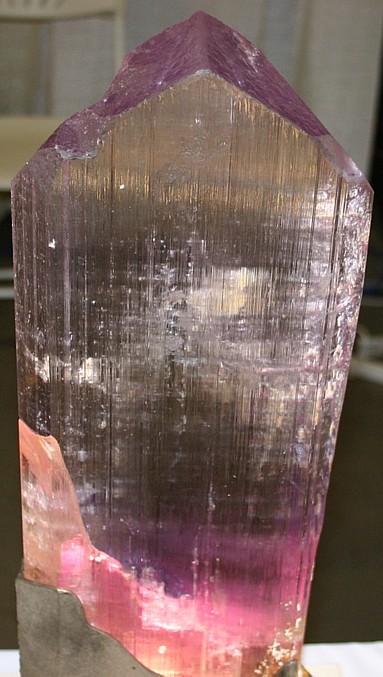|
.
Kunzite Mineral Facts:
Chemical Formula: LiAlSi2O6
Kunzite is a color
variety of spodumene which is used as a gemstone. Spodumene
is a
member of the pyroxene mineral
family.
Colors:
white, gray, green or yellowish
green, blue, violet to amethystine.
Hiddenite variety is green, the pink to violet to purple or even blue
varieties are named Kunzite. A color center (electron hole) is thought
to be present acting as a coloring agent to give Kunzite its color.
Both the gem
varieties kunzite and
hiddenite are noted for their strong pleochroism, they are darker
looking down the C axis.
Hardness:
6.5 to 7
Density: 3.18
Cleavage:
Two
planes yielding a perfect prismatic cleavage.
Crystallography: Monoclinic
Most crystals
are striated vertically. Twins are fairly common. Although crystals are
common the mineral also frequently occurs as platy or scaly aggregates.
Luster:.
Vitreous luster which
can be pearly on cleavage surfaces.
Optics:
(Refractive Index): = a =1.651,
b=1.669, y=1.677.
|
 |
.
|
Composition,
Structure and Associated Minerals:
Spodumene
occurs in granites, pegmatites and crystalline schists, where it was formed
by pneumatolytic processes. A comparatively rare species, but found
occasionally in very large crystals in certain pegmatite dikes. At the Etta
Mine, Black Hills, South Dakota, are many 30 ft. long and 3-4 ft. in
diameter. One measured 47 ft. in length. At the Etta tin pegmatite in
Pennington County, South Dakota, it is often associated with
cassiterite. As a constituent of Lithium rich pegmatites in
California it often occurs associated with lepidolite and
tourmaline, and it has been mined for its lithium content. The
best-known gem varieties are Hiddenite and kunzite. There is, however, a
yellow transparent variety of spodumene; specimens of this variety occur
associated with
chrysoberyl in Brazil, and are sometimes sold as chrysoberyl, from
which, however, they can readily be distinguished by their inferior hardness
and lower specific gravity. Spodumene alters readily to albite, muscovite,
eucryptite, or mixtures of these minerals.
Identification and Diagnostics
Before the blowpipe
spodumene
swells up and
throws out fine
branches at first,
eventually
fusing
to a
clear,
colorless glass, at
the same time imparting a crimson color to the flame (test for lithium). It
is unattacked by ordinary acids. It melts at about 1325. Its powder reacts
alkaline.
It is recognized by its cleavage, positive test for lithium and associated
minerals.
Occurrence,
Localities and Origins:
Kunzite, a pink or lilac
variety, from San Diego Co., California. Under the influence of radium rays
it becomes green. When heated to 240 it becomes a darker rose color, but at
400 it loses all color. Kunzite is named after G. F. Kunz, an American gem
expert. This is a pale-pink or lilac-colored variety of spodumene, first
found in a pegmatite vein on Pala Mt., San Diego Co., California, associated
with muscovite, lepidolite, and tourmaline. The tourmaline occurring with it
is represented by red, blue, green and black varieties and is in part
of gem quality. Kunzite is also found in the pegmatites of Madagascar,
Afghanistan, Pakistan and Brazil associated with lepidolite, tourmaline, and
morganite pink beryl. Kunzite can occur in very large crystals, suitable
to cut gems of several hundred carats. The colors of Kunzite will all fade
away to colorless
on prolonged
intense exposure to sunlight. The color can be resorted on exposure to
radiation which first turns the crystal green, the green fading quickly in
light to the paler Kunzite color.
The
ordinary varieties of the mineral were once used as a source of
lithium in the manufacture of lithium salts, and the transparent varieties
are used as gems. Ordinary ash-grey spodumene is of no value as a gemstone;
as noted it was once used as a source of lithium salts, but easier sources
exit and are now worked.
For More information on this gem see:
Kunzite Spodumene
Return to the
Mineral Collectors Information Page |
 |
|


